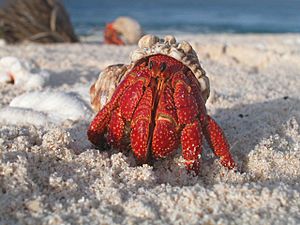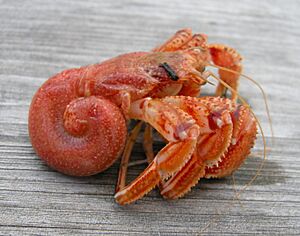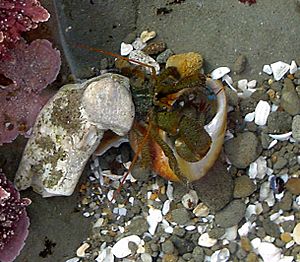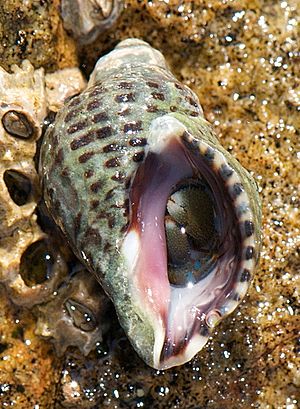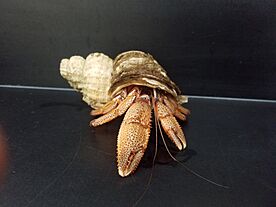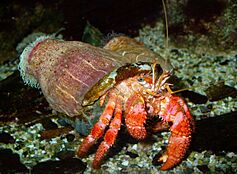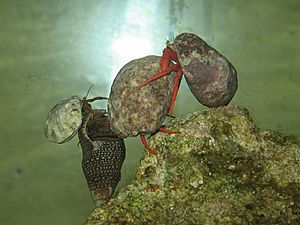Hermit crab facts for kids
Quick facts for kids Hermit crab |
|
|---|---|
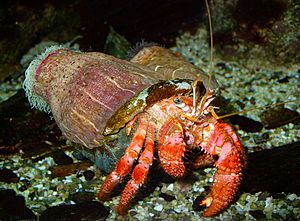 |
|
| Dardanus calidus | |
| Scientific classification |
|
| Kingdom: | Animalia |
| Phylum: | Arthropoda |
| Subphylum: | Crustacea |
| Class: | Malacostraca |
| Order: | Decapoda |
| Infraorder: | Anomura |
| Superfamily: | Paguroidea Latreille, 1802 |
| Families | |
|
|
A hermit crab is a type of crab that does not have a hard shell of its own. To stay safe, they use empty shells left behind by other sea creatures. They especially like old whelk shells. As a hermit crab grows bigger, it needs to find a larger shell to move into.
Contents
Understanding Hermit Crabs
Hermit crabs are actually more closely related to squat lobsters and porcelain crabs than to "true" crabs. There are about 1100 different kinds of hermit crabs, divided into eight main families.
Types of Hermit Crabs
Hermit crabs can be split into two main groups:
- Aquatic Hermit Crabs: Most hermit crabs live underwater in the ocean. They can be found in shallow reefs or deep sea areas. They breathe using gills, and while they can survive for a short time out of water if their gills stay wet, they mostly stay submerged. Some aquatic hermit crabs do not use a mobile shell. Instead, they live in fixed structures like old worm tubes, corals, or sponges.
- Land Hermit Crabs: These crabs spend most of their lives on land, usually in warm, tropical places. Even though they live on land, they still need access to both fresh and salt water. They need water to keep their gills wet so they can breathe and to help them reproduce. The Coenobitidae family includes all land hermit crabs.
Hermit Crab History
Scientists have found fossils of hermit crabs using gastropod shells that date back to the Late Cretaceous period. Before that, some hermit crabs used ammonite shells for protection. The oldest known hermit crab species lived about 200 million years ago!
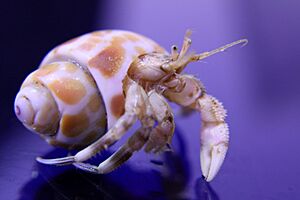
What Hermit Crabs Look Like
Most hermit crabs have long, soft bodies that curve in a spiral shape. Unlike other crabs, their bodies are not hard. This soft body part, called the abdomen, is very vulnerable. To protect themselves from animals that want to eat them, hermit crabs carry an empty seashell. They can pull their whole body inside the shell if they feel threatened. They usually use shells from sea snails, but some might use shells from other creatures or even hollow pieces of wood or stone. The end of a hermit crab's abdomen is specially shaped to hold tightly onto the inside of the snail shell. Most hermit crabs are active at night, which means they are nocturnal.
Reproduction and Life Cycle
Hermit crabs come in many sizes. Some have a body only a few millimeters long. Others, like Coenobita brevimanus, can live for 12 to 70 years and grow as big as a coconut! The coconut crab is the largest land invertebrate in the world, and it is a type of hermit crab that does not use a shell as an adult.
Young hermit crabs go through several stages. The first two stages happen inside the egg. Most hermit crab babies hatch at the third stage, called the zoea. At this stage, they have long spines, a narrow body, and large antennae. After several molts (shedding their skin), they reach their final baby stage, called the megalopa.
The reproductive parts of hermit crabs are located near their heart. For mating, both the male and female crabs move partly out of their shells. After mating, female hermit crabs usually lay their eggs soon after. However, they can also store sperm for many months. The eggs are fertilized as they are laid. The female carries the eggs in a mass attached to her abdomen inside her shell until they hatch. The number of eggs is usually large and depends on the size of the crab.
Shells and How Crabs Change Them
As hermit crabs grow, they need bigger shells. Finding a good, empty shell can be hard, so hermit crabs often compete for them. The number of empty shells available depends on how many snails are around and how many hermit crabs need shells of a certain size.
Hermit crabs that have shells too small for them cannot grow as fast. They are also more likely to be eaten because they cannot fully hide inside their shell.
Shells used by hermit crabs are often changed by previous owners. A hermit crab will hollow out the shell, making it lighter and easier to carry. Only small hermit crabs can live in shells that have not been changed. Big hermit crabs that are put into a normal, heavy shell often die. Hollowing out a shell takes a lot of energy, so crabs prefer shells that are already modified. They use both chemicals and their bodies to carve out the inside of the shell. These modified shells can last for many generations of hermit crabs. This helps crabs live in places where snails might have disappeared.
Sometimes, when natural shells are not available, hermit crabs will use other things like tin cans, broken glass, or plastic trash. This is often very dangerous for them because they can get into these items but cannot get out. This can even cause more deaths, as a dead hermit crab releases a smell that attracts other hermit crabs, leading them to the same dangerous trap.
Some larger marine hermit crabs carry one or more sea anemones on their shell. The anemones help scare away animals that might want to eat the crab. The sea anemone also benefits by eating bits of food that the hermit crab drops. Other crabs have tiny animals called bryozoans growing on their shells.
In 2024, scientists found that 10 out of 16 land hermit crab species were using artificial shells, including plastic waste, broken glass, and light bulbs, instead of natural shells.
Shell Fights
Shell fighting is a common behavior among hermit crabs. It happens when a crab tries to steal another crab's shell, usually when there are no empty shells available that fit. These fights usually happen between crabs of the same species, but sometimes different species fight too.
If the crab defending its shell does not hide inside, an aggressive interaction will happen. This continues until the defending crab hides or the attacker leaves. Once the defender hides, the attacker will often turn the shell over many times, holding it with its legs. Then, it puts its claws into the shell's opening.
Next, the crabs start a "positioning" behavior. The attacker moves side to side over the opening of the defender's shell, often in a figure-eight shape. After this, the attacker begins "rapping." The attacker holds its legs and body still, then quickly moves its own shell down onto the defender's shell. This makes a sound. It seems like the crabs themselves do not touch much during this.
After several "raps," the defending crab might come completely out of its shell. The attacker then checks the now-empty shell and quickly switches into it. The crab usually holds onto its old shell in case it wants to switch back. The defeated crab then tries to get into the empty shell. If the defeated crab does not stay close to the shells, it might get eaten by other animals.
Some hermit crab species, both on land and in the sea, form a "vacancy chain" to exchange shells. When a crab finds a new empty shell, or takes one from another crab, it will leave its own shell and check if the new shell fits. If the new shell is too big, the crab goes back to its own shell. Then, it waits by the vacant shell for up to 8 hours. As more crabs arrive, they also check the shell. If it is too big for them, they wait too, forming a line of up to 20 crabs, holding onto each other from largest to smallest. As soon as a crab that is the right size arrives and takes the vacant shell (leaving its old shell empty), all the crabs in the line quickly switch shells, each moving up to the next size. If the first shell was taken from another hermit crab, that crab is often left without a shell and might get eaten. Hermit crabs sometimes team up against another crab with a better shell, pulling it away before fighting over it.
Aggressive Actions
Hermit crabs show similar aggressive behaviors, though there are some differences between species. They often move or position their legs and claws (also called pincers). These displays are usually enough to avoid a real fight. Sometimes, two crabs will do many actions without a clear pattern. These face-offs usually last a few seconds, but some can last several minutes for very stubborn crabs.
They might also raise a leg, which is sometimes called an "ambulatory raise." This can happen with one leg, two legs, or even all four walking legs. The exact way they do this varies by species. In some species, they move their leg away and up from their body, then bring it down while moving forward. This is sometimes called an "ambulatory poke."
Hermit crabs also use their claws as a warning. There are two main ways they do this. The first is called "cheliped presentation." The crab lifts its whole body (including its shell) and spreads its legs. Then, it moves its claw forward until the top part of the claw is straight up. This position can look different in various species, like those in the Pagurus group. The second way is called "cheliped extension." This is mostly a visual warning, but it can sometimes be used to push another crab. The claws move forward and up until they are parallel with the ground. If a bigger crab pushes a smaller one, the smaller crab can be moved several centimeters.
Crabs in the Paguridae family have another unique movement. They might crawl onto another crab's shell. If the size is just right, the crab being climbed on might move quickly up and down or sideways, usually causing the other crab to fall off.
Living in Groups
Some hermit crab species, like Clibanarius tricolor, Calcinus tibicen, and Pagurus miamensis, like to live in groups. Clibanarius tricolor forms the largest and densest groups. These crabs gather together during the day and usually stay with the same group day after day. In the late afternoon, they start moving as a group and leave their gathering spot. These groups usually move in one direction and might stay close to other groups of crabs. However, this group behavior seems to disappear when crabs are kept in controlled environments.
Hermit Crab Friends
The shells of hermit crabs often have other creatures living on or in them. These "associates" are usually divided into two groups: those that live inside the shell and those that live on the outside.
Some creatures that live inside the shell include nereid worms. These worms have a commensal relationship with the crab, meaning one benefits and the other is not harmed. The worms help keep the hermit crab's shell clean, along with crabs from the Porcellanidae family. It is common to see both worms and crabs in the same shell.
There are also relationships with amphipods. For example, the hermit crab species Pagurus hemphilli often lives with the amphipod genus Liljeborgia. This amphipod's colors match the hermit crab and the algae that often grow on its shell. P. hemphilli crabs do not mind these guests, while other hermit crab species might try to eat them.
Creatures that live on the outside of the shell are called epifauna. These can include barnacles and Crepidula. Sometimes, these can be a problem for the crab, as they might make the shell unstable or too heavy. Some hermit crab species have colonies of tiny animals called Hydractina living on their shells. Other species actively attach and re-attach sea anemones to their shells. Most hermit crabs try to have as many anemones as possible, and some even steal anemones from other hermit crabs. The crab and the anemone have a helpful relationship: the anemone helps protect the crab from predators, and it gets to eat bits of the crab's meals.
Hermit Crabs as Pets
Many types of marine hermit crabs are popular in marine aquariums. They are often kept in fish tanks with other reef animals.
Of the about 15 land hermit crab species in the world, a few are commonly kept as pets. These include the Caribbean hermit crab (Coenobita clypeatus), the Australian land hermit crab (Coenobita variabilis), and the Ecuadorian hermit crab (Coenobita compressus). Other species are becoming more popular as pets too.
Hermit crabs are sometimes thought of as pets that do not live long, but species like Coenobita clypeatus can live for 20 years or more if cared for properly. Some have even lived longer than 32 years!
Here are some basic things you need to keep pet hermit crabs:
- Humidity gauges: The air in their tank needs to be 75-85% humid.
- Temperature gauges: The temperature should be 70-75°F (21-24°C).
- Substrate: They need deep, soft sand or coconut fiber to dig in, especially when they need to molt (shed their skin).
- Tank size: A minimum of a 5-gallon tank for one crab, and a 10-gallon tank for about 20 crabs.
- Shells: Provide extra shells of different sizes, as crabs change shells as they grow.
- Water dishes: They need a dish of fresh water and a pool of salt water (made with aquarium salt) deep enough to submerge themselves.
See also
 In Spanish: Paguroidea para niños
In Spanish: Paguroidea para niños


